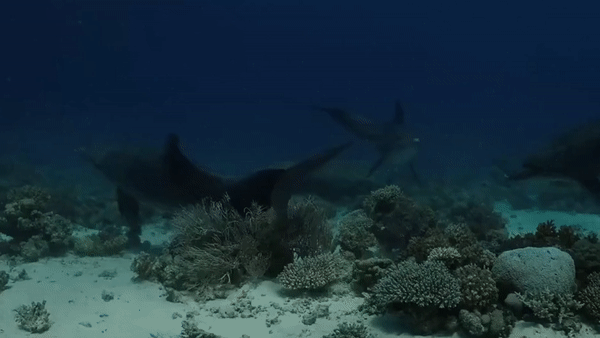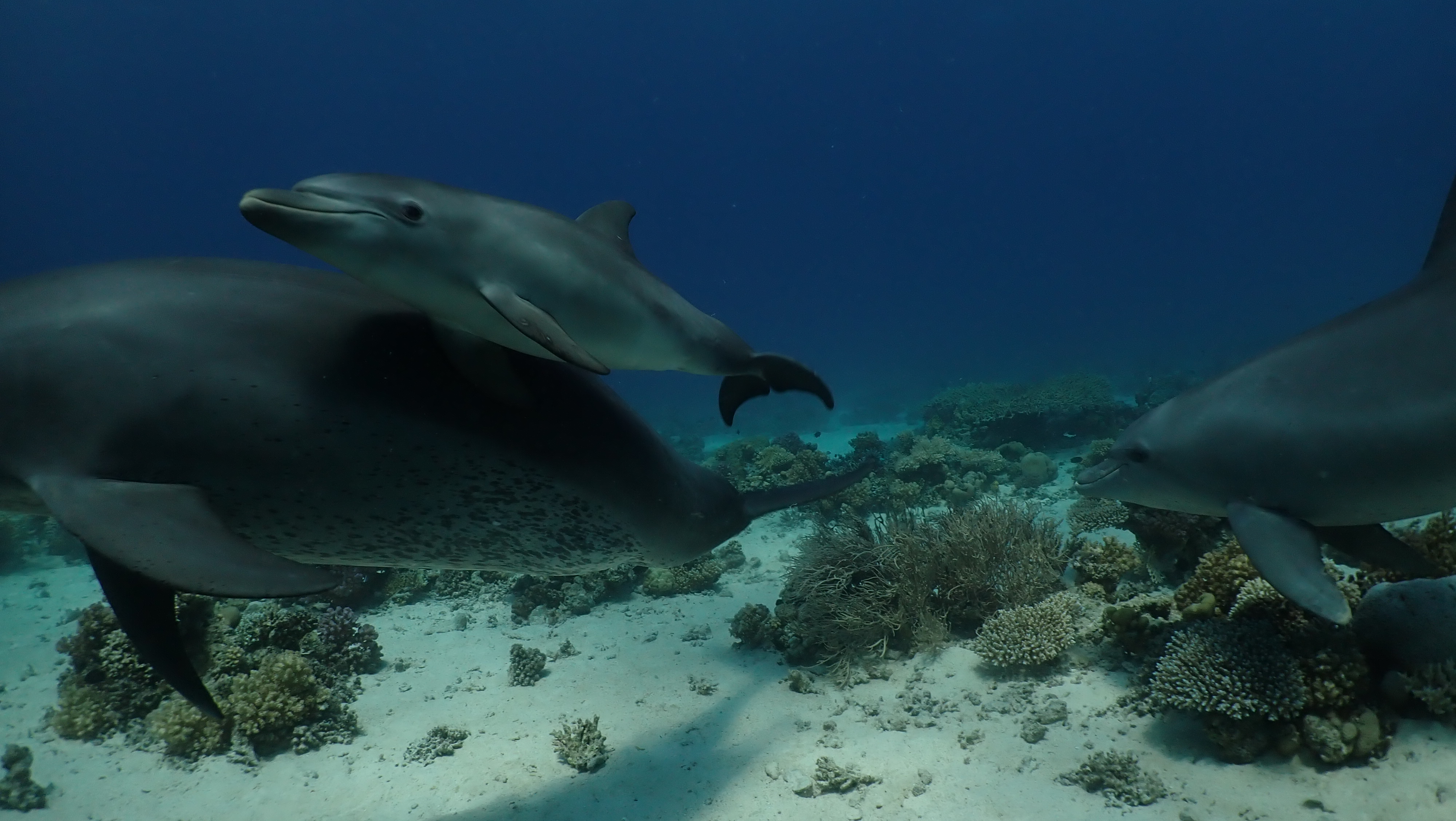Red Sea dolphins slather their skin in coral mucus, because nature is wonderfully gross
Coral mucus contains bioactive compounds.

Indo-Pacific bottlenose dolphins take their skin care seriously — in fact, the marine mammals medicate their skin by rubbing up against certain types of corals and sponges, which produce compounds that may help guard the dolphins' skin against infection.
Scientists first saw these dolphins scraping their slippery skin against corals about 13 years ago, in the Red Sea off the coast of Egypt. It was then that a team of researchers — including Angela Ziltener, a wildlife biologist at the University of Zurich — spotted the dolphins gliding toward and nuzzling against a bush-like coral species known as gorgonian coral (Rumphella aggregata).
Divers had anecdotally observed this behavior in the past, but it hadn't yet been studied, Ziltener and her collaborator Gertrud Morlock, an analytical chemist and food scientist at Justus Liebig University Giessen in Germany, told Live Science in a joint statement.
The researchers suspected that the dolphins might use the corals to self-medicate, since gorgonian coral is known to excrete mucus with antimicrobial properties. As the scientists continued to observe the dolphins, the team noticed that the animals also rubbed their bodies against leather corals in the genus Sarcophyton, and a genus of sponges called Ircinia. Like the gorgonian coral, these other invertebrate organisms are known to produce bioactive substances, although how those substances might benefit dolphins was unknown.
Related: These dolphins taught each other to moonwalk — but it was just a fad
Now, in a new study published Thursday (May 19) in the journal iScience, scientists have pinpointed more than a dozen bioactive compounds that are produced by these corals and sponges and which likely help maintain dolphins' skin health. By regularly coating their silver-gray bodies in these compounds, the dolphins may prevent and treat skin infections, as well as generally maintain their skin microbiome — the community of microorganisms living on their flesh.
Since they first visited the Red Sea in 2009, the research team has repeatedly returned to the site to scuba dive amongst a pod of about 360 Indo-Pacific bottlenose dolphins (Tursiops aduncus) that live near the coastal Egyptian cities of Hurghada and El Gouna. Through a combination of boat-based surveys from the sea surface and close-up underwater observations, the team came to recognize the dolphins' typical behavior patterns.
Get the world’s most fascinating discoveries delivered straight to your inbox.
The dolphins often queued up behind one another, seemingly waiting their turn to slide through the branches of a gorgonian coral or rub their heads against a hard Ircinia sponge, the team observed. Once rubbed, these invertebrates released mucus that then transferred to the dolphins' skin. When the dolphins rubbed against a coral or sponge especially vigorously, their skin sometimes became stained a "striking" yellowish or greenish color, due to the compounds excreted by the invertebrates, the authors wrote in their report.

The youngest dolphins, less than 1 year old, seemed to observe as the mature dolphins rubbed against the corals and sponges; then, in time, these younger dolphins tried out the behavior themselves, first by lightly touching the corals with part of their body and then swiftly swimming away. These observations hint that each generation of dolphins picks up the coral-rubbing behavior through social learning, rather than knowing how to do so innately, the authors wrote.
In addition to collecting photos and videos of the dolphins, the researchers sampled small pieces of the animals' preferred corals and sponges. Back in the lab, Morlock and her team carefully separated each sample into its component compounds and determined their identities using a technique called high-resolution mass spectrometry.
Related: Amazing video shows a mom chimp medicating her child's wound with insects
The chemists also assessed the bioactive properties of each compound, by testing whether a given substance effectively killed bacteria or interfered with the activity of specific enzymes, for example.
These analyses revealed 17 bioactive substances, 10 of which showed antibacterial effects against both gram-positive and gram-negative bacteria; these two groups of bacteria differ in the structure of their outer cell walls and membranes and thus react differently to antibacterial compounds.
Some of the substances acted as antioxidants, while others showed estrogen-like effects. These hormone-like compounds were specifically produced by the leather coral and may help to maintain dolphins' skin hydration and elasticity, Ziltener and Morlock told Live Science. The leather coral also produced small amounts of toxic substances that could help eliminate parasites on the skin surface, they said.
One limitation of the study is that the biological effects of these compounds were assessed in the lab, not on dolphin skin, the authors told Live Science. In theory, these compounds should have some effect when the dolphins shimmy against them on the reef, but based on their current research, the team can't determine exactly how the substances regulate the skin microbiome or which specific infections they treat most effectively.
Another limitation of the study is that the researchers didn't examine other Red Sea corals, just the species the dolphins preferred, said Luke Rendell, a biologist at the University of St. Andrews in Scotland, who was not involved in the study.
"There isn’t evidence that the corals used for rubbing are special in their chemical properties," Rendell told Live Science in an email. "The case would be strengthened if the study also showed that non-selected corals didn’t have these properties." Such evidence would bolster the idea that the dolphins specifically seek out the medicinal corals and sponges for their healing properties.
That said, the research does begin to connect the dots between the dolphins' affinity for specific corals and the medicinal properties of said corals.
"Based on the behavioral observations and the profound analytical data obtained, we dared to hypothesize that the bioactive molecules can have an effect upon skin contact," Ziltener and Morlock told Live Science. Such self-medication has never been documented in a dolphin, whale or porpoise, making this study a fascinating first.
Originally published on Live Science.

Nicoletta Lanese is the health channel editor at Live Science and was previously a news editor and staff writer at the site. She holds a graduate certificate in science communication from UC Santa Cruz and degrees in neuroscience and dance from the University of Florida. Her work has appeared in The Scientist, Science News, the Mercury News, Mongabay and Stanford Medicine Magazine, among other outlets. Based in NYC, she also remains heavily involved in dance and performs in local choreographers' work.


